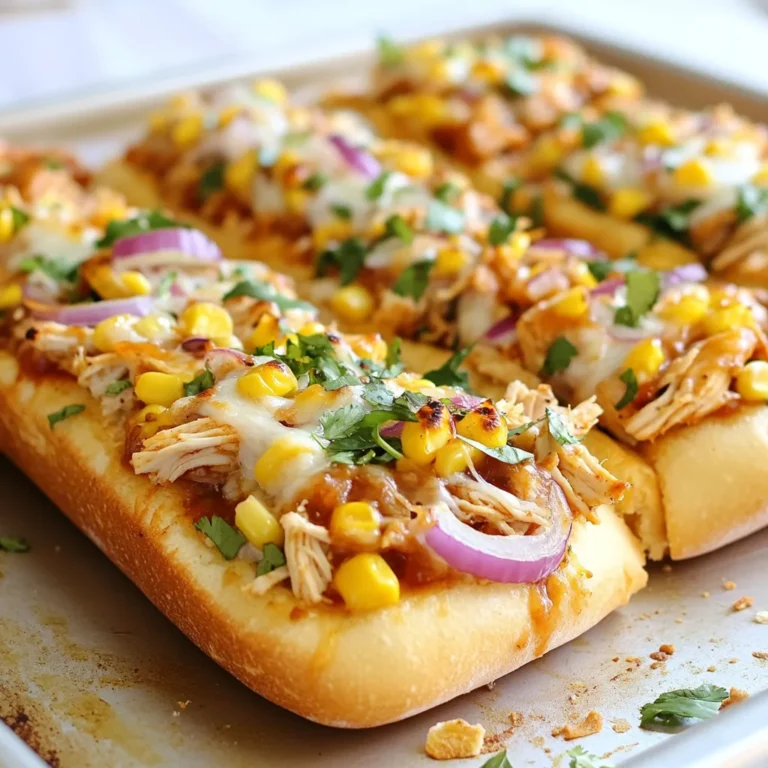Teriyaki Tofu Stir-Fry Quick and Flavorful Meal
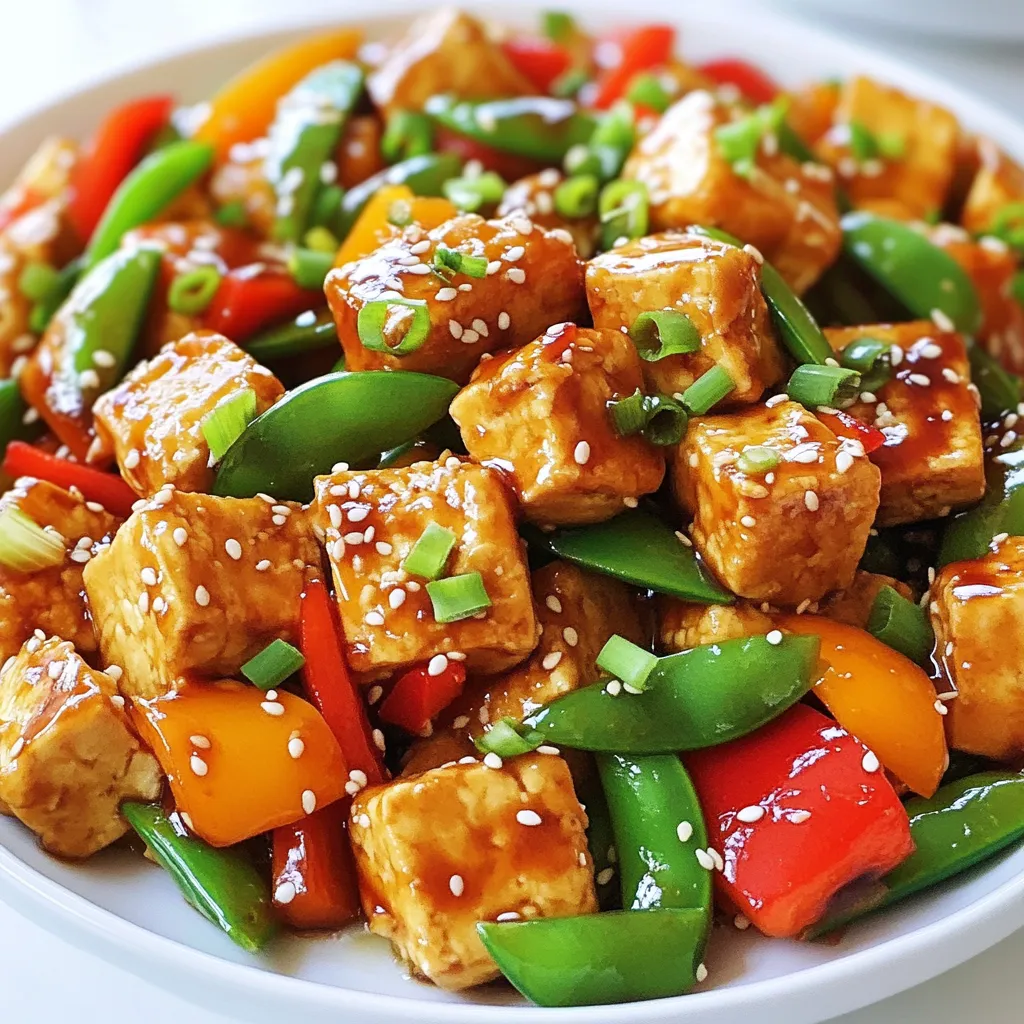
Looking for a quick and tasty meal? Teriyaki Tofu Stir-Fry is here to delight your taste buds! This dish combines firm tofu and fresh veggies like bell peppers and snap peas, all coated in a flavorful teriyaki sauce. In just a few easy steps, you can whip up a dinner that’s both satisfying and nutritious. Ready to impress your family or friends? Let’s dive into this delicious recipe!
Why I Love This Recipe
- Easy to Make: This recipe is straightforward and quick, making it perfect for weeknight dinners or meal prep.
- Healthy Ingredients: Packed with colorful vegetables and protein-rich tofu, this dish is both nutritious and satisfying.
- Flavor Explosion: The combination of soy sauce, ginger, and sesame oil creates a deliciously rich and savory flavor that’s hard to resist.
- Customizable: You can easily swap in your favorite vegetables or adjust the sauce for a personal touch, making it versatile for any palate.
Ingredients
Main Ingredients
– 14 oz (400g) firm tofu, drained and pressed
– 1 red bell pepper, sliced into thin strips
– 1 green bell pepper, sliced into thin strips
– 1 cup snap peas, trimmed for freshness
– 1 medium carrot, julienned into matchstick pieces
– 3 green onions, chopped (keep whites and greens separated)
– 2 cloves garlic, minced finely
– 1 tablespoon fresh ginger, minced
Sauce Ingredients
– 1/4 cup low-sodium soy sauce
– 2 tablespoons mirin (or vinegar)
– 1 tablespoon brown sugar, packed
– 1 tablespoon sesame oil
Optional Garnishes
– Sesame seeds
– Lime wedges
Gather these fresh and tasty ingredients. Firm tofu serves as the main protein source. The bell peppers add color and crunch. Snap peas bring a sweet taste, while the carrot adds a nice texture. Garlic and ginger give a fragrant kick. The sauce combines soy sauce, mirin, brown sugar, and sesame oil for a sweet and savory flavor. For a finishing touch, sprinkle sesame seeds and serve with lime wedges for extra zest. This blend of ingredients creates a well-rounded, delicious dish.
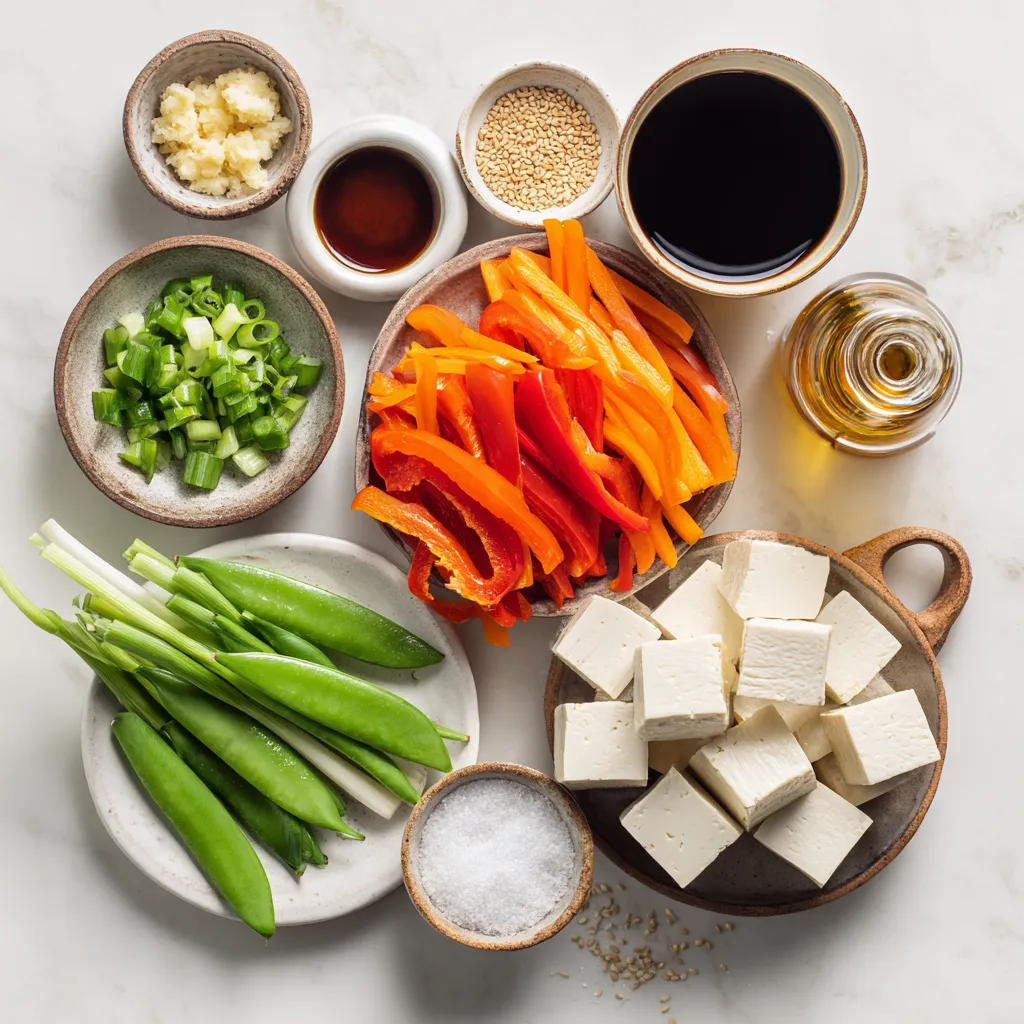
Step-by-Step Instructions
Preparing the Tofu
– Cut the pressed tofu into bite-sized cubes.
– Toss the tofu cubes in cornstarch until each piece is coated. This step gives the tofu a crispy texture.
Cooking the Tofu
– Heat 1 tablespoon of vegetable oil in a non-stick skillet over medium-high heat.
– Add the tofu cubes. Fry them for about 8-10 minutes. Turn them often until they are golden brown on all sides. Once done, take the tofu out and set it aside on a plate.
Stir-Frying the Vegetables
– In the same skillet, add another tablespoon of oil.
– Add the sliced red and green bell peppers, snap peas, and julienned carrot. Stir-fry for about 5 minutes until the veggies are tender but still crisp.
– Add the minced garlic, minced ginger, and the chopped white parts of the green onions. Stir-fry these for 1-2 minutes, letting the flavors mix.
Combining Ingredients
– In a small bowl, mix the low-sodium soy sauce, mirin (or vinegar), brown sugar, and sesame oil. Whisk until the sugar dissolves.
– Pour the sauce over the sizzling veggies in the skillet. Stir well to coat everything.
– Gently add the crispy tofu back into the skillet. Toss everything together to coat the tofu in the sauce. Cook for another 2-3 minutes until heated through.
Serve your Teriyaki Tofu Stir-Fry right away. Enjoy with a sprinkle of sesame seeds and green parts of the chopped green onions for a fresh touch.
Tips & Tricks
Perfecting the Tofu Texture
To get that perfect tofu texture, cornstarch is key. It creates a crispy crust when you fry the tofu.
– Coat the Tofu: After pressing the tofu, cut it into cubes. Toss those cubes in cornstarch until each piece is covered. This helps achieve crunchiness.
– Frying Techniques: Heat oil in a non-stick skillet until hot. Add the cornstarch-coated tofu. Fry it for 8-10 minutes, turning until golden brown. This method gives you the best crisp.
Enhancing Flavor
Fresh herbs can really boost the taste of your dish. Consider adding basil or cilantro for a fresh twist.
– Sauce Substitutions: If you run out of mirin, apple cider vinegar works great. It adds a nice tang.
Presentation Ideas
Serve your Teriyaki Tofu Stir-Fry over fluffy jasmine rice or quinoa. This pairing makes for a filling meal.
– Garnishing Tips: A sprinkle of sesame seeds adds a nice crunch. Green onion tops also bring a pop of color. Consider adding a lime wedge for extra zest!
Pro Tips
- Press Tofu Thoroughly: Make sure to press the tofu for at least 30 minutes to remove excess moisture. This step is crucial for achieving that perfect crispy texture when frying.
- Use High Heat: When stir-frying, always use high heat. This helps to quickly cook the vegetables while preserving their crispness and vibrant colors.
- Customize Your Sauce: Feel free to tweak the sauce by adding chili flakes for heat or a splash of lime juice for acidity. This can elevate the overall flavor profile of the dish.
- Garnish for Appeal: Don’t skip the sesame seeds and green onion garnish! They not only add visual appeal but also enhance the dish’s flavor with their nutty and fresh notes.
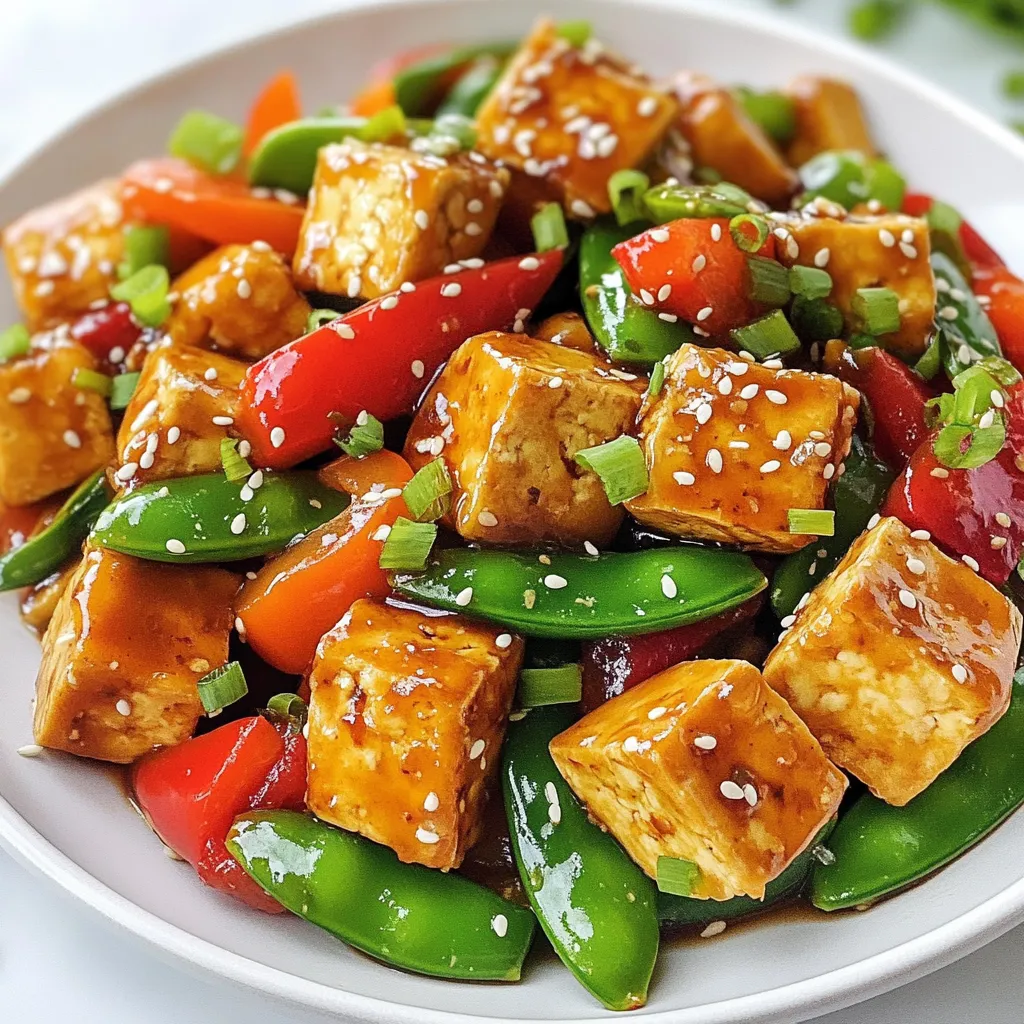
Variations
Protein Alternatives
You can switch out tofu for tempeh. Tempeh has a nuttier taste and a firmer bite. It works well with teriyaki sauce and takes on flavors nicely. If you prefer meat, try adding chicken or shrimp. Both cook quickly and soak up the sauce flavor.
Vegetable Swaps
Feel free to mix in other vegetables. Broccoli, zucchini, or mushrooms can add new flavors. You can also use seasonal veggies. In summer, add fresh corn or bell peppers. In winter, try carrots or bok choy for a cozy dish.
Sauce Modifications
Adjust the sweetness by adding more brown sugar or using honey. If you like heat, add chili flakes or sriracha. This can make your stir-fry spicier and more exciting. Experiment with flavors to find your perfect balance!
Storage Info
Refrigerating Leftovers
To keep your Teriyaki Tofu Stir-Fry fresh, store it in the fridge. Use airtight containers to prevent moisture loss. Glass or plastic containers work well. Make sure to let it cool down before sealing.
Reheating Instructions
For reheating, use a skillet over medium heat. This keeps the tofu crispy. Add a splash of water to the pan to create steam. Cover it briefly to heat through. You can also use a microwave, but it may soften the tofu.
Freezing Guidelines
Yes, you can freeze Teriyaki Tofu Stir-Fry. Place it in freezer bags or containers. Remove as much air as possible. For thawing, leave it in the fridge overnight. Reheat in a skillet to restore texture.
FAQs
How do I make tofu crispy in stir-fries?
To make tofu crispy, start with firm tofu. Press it well to remove excess water. Cut it into small cubes. Coat the cubes in cornstarch. This creates a nice crunch when fried. Heat oil in a pan until hot. Fry the tofu until golden brown on all sides. This method gives you that perfect crispy texture.
Can I use different vegetables in this recipe?
Yes, you can use any vegetables you like! Broccoli, zucchini, or mushrooms work well. Just cut them into similar sizes for even cooking. You can mix and match based on what you have at home. Each vegetable adds its own flavor and texture to the stir-fry.
What can I substitute for mirin?
If you don’t have mirin, apple cider vinegar is a great substitute. It gives a zesty kick. You can also mix water and sugar as another option. Just keep the ratio balanced for the right taste. Both options will still enhance the flavor of your stir-fry.
Is Teriyaki Tofu Stir-Fry gluten-free?
Yes, Teriyaki Tofu Stir-Fry can be gluten-free. Use gluten-free soy sauce instead of regular soy sauce. Always check labels to ensure all ingredients meet gluten-free standards. This way, you can enjoy the dish without any worries.
How long can I store the stir-fry in the fridge?
You can store the stir-fry in the fridge for up to three days. Keep it in an airtight container to keep it fresh. Reheat it on the stove or microwave before serving. This will help maintain the flavor and texture.
This blog post covered making Teriyaki Tofu Stir-Fry from start to finish. We explored main ingredients, sauce options, and cooking methods. You can enhance flavor with fresh herbs or swap proteins for variety. Don’t forget storage tips to keep leftovers fresh.
Teriyaki Tofu Stir-Fry is tasty, flexible, and easy to prepare. Enjoy making this dish your ow
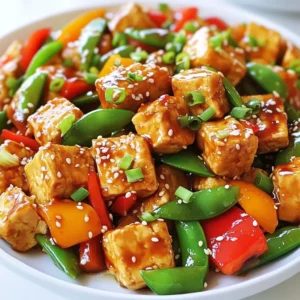


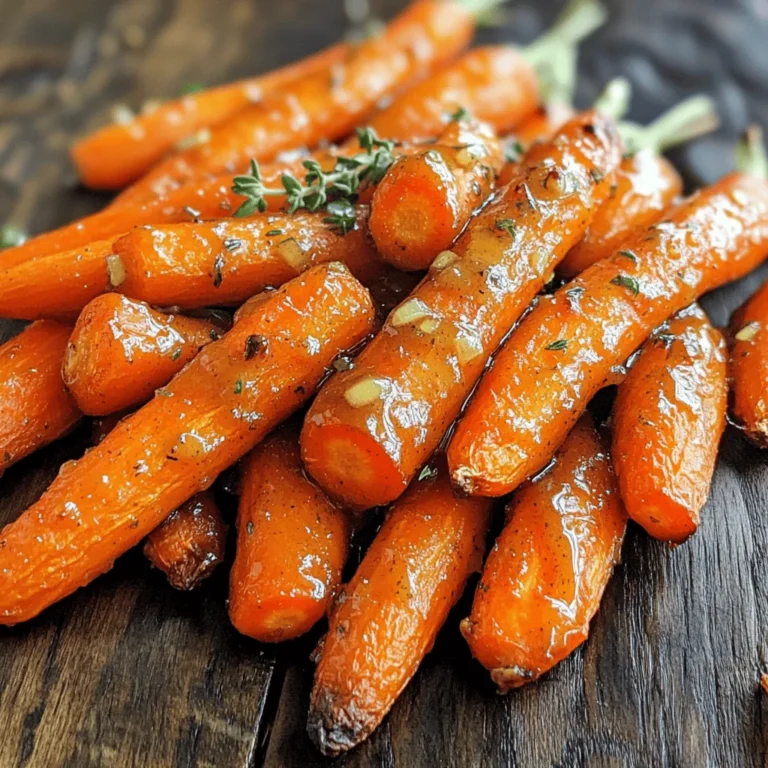
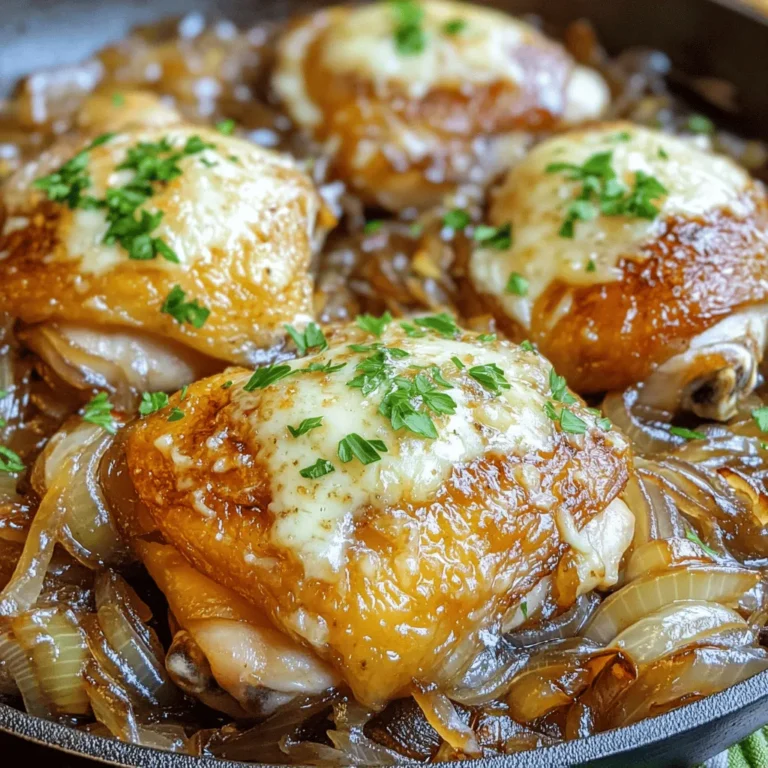
. Enjoy your cooking! Choosing the right chickpeas You can use canned chickpeas for ease. Just make sure to drain and rinse them well. This removes extra salt and makes them taste fresher. If you prefer, soak dried chickpeas overnight. This gives a firmer texture. Cook them until soft before adding to your stew. Spice adjustments and substitutions Spices are key to Moroccan flavors. If you want more kick, add cayenne pepper. For a different taste, swap smoked paprika for regular paprika. You can also try turmeric for a vibrant color and health boost. Feel free to adjust the salt and pepper to your liking. Cooking time adjustments for texture Cooking time affects the stew's texture. For softer vegetables, simmer longer. If you like a crunch, reduce the cooking time. Always check the stew as it cooks. This way, you can get the perfect blend of soft chickpeas and tender veggies. For the full recipe, check the details above. {{image_4}} To make Moroccan chickpea stew your own, you can swap some ingredients. Here are a few ideas: - Adding other vegetables: Sweet potatoes lend a nice sweetness. You can also try adding kale for a nutritious boost. - Using different beans or legumes: Kidney beans or lentils can replace chickpeas if you want a change. - Modifying spices to suit taste preferences: If you love heat, consider adding cayenne pepper. Or, reduce spice for a milder flavor. These swaps keep the stew fresh and exciting while fitting your taste. Pairing this warm stew with the right sides enhances the meal. Here are some great options: - Recommended sides: Crusty bread or warm pita is perfect for scooping. You can also serve it with fluffy rice for a hearty meal. - Pairing with beverages: A light-bodied red wine or herbal tea complements the flavors well. For a refreshing choice, try mint lemonade. These suggestions add to the experience, making each bite even more enjoyable. To keep your Moroccan Chickpea Stew fresh, follow these steps: - Refrigeration tips: Place the stew in an airtight container. It will last in the fridge for up to 4 days. Ensure it cools down before sealing the container to avoid condensation. - Freezing instructions: If you want to freeze it, use freezer-safe containers. The stew can stay good for 3 months in the freezer. Just leave some space at the top, as it may expand when frozen. When it's time to enjoy your stew again, reheating is key. - Best methods for reheating the stew: The best way is on the stove. Pour the stew into a pot and heat it over medium heat. Stir it often to ensure even heating. You can also use the microwave. Heat in a microwave-safe bowl, covering it loosely. Heat in short bursts and stir between to prevent hot spots. - Avoiding loss of texture and flavor: To keep the stew's texture, add a splash of vegetable broth or water during reheating. This helps maintain moisture. Always taste and adjust seasoning after reheating, as flavors can mellow. For the full recipe, you can refer to the earlier section. Can I make this stew in a slow cooker? Yes, you can! Start by sautéing the onion and garlic in a pan. Then, transfer them to your slow cooker. Add all the other ingredients, except the spinach and lemon. Cook on low for about 6-8 hours or high for 3-4 hours. Add spinach before serving. How can I make it spicier? To add heat, use fresh chili peppers or red pepper flakes. You can also add a dash of cayenne pepper. Start with a small amount and adjust to your taste. Is it possible to make this stew ahead of time? Absolutely! This stew tastes even better the next day. Make it ahead and store it in the fridge for up to three days. Reheat before serving to enjoy the rich flavors. Can I substitute fresh herbs for dried? Yes, you can! Use three times more fresh herbs than dried. So, if a recipe calls for one teaspoon of dried, use three teaspoons of fresh. Fresh herbs will add a vibrant flavor. What is the nutritional information for Moroccan Chickpea Stew? This stew is packed with nutrients! A serving typically contains about 250 calories, 10 grams of protein, and 8 grams of fiber. It’s a great source of vitamins from the veggies and chickpeas. For the full recipe, check out the detailed steps above. This article covered a tasty Moroccan Chickpea Stew. I shared the main ingredients, cooking steps, and helpful tips to perfect your dish. You can swap ingredients or adjust spices for your liking. Remember to store and reheat leftovers properly. This stew is not just healthy; it’s also fun to make. Enjoy sharing it with family and friends. Embrace exploring flavors and making this dish your own. Cooking can be easy and enjoyable.](https://goldendishy.com/wp-content/uploads/2025/06/4667d82b-b7b2-4094-8ffc-7c6a096b6e6d-768x768.webp)
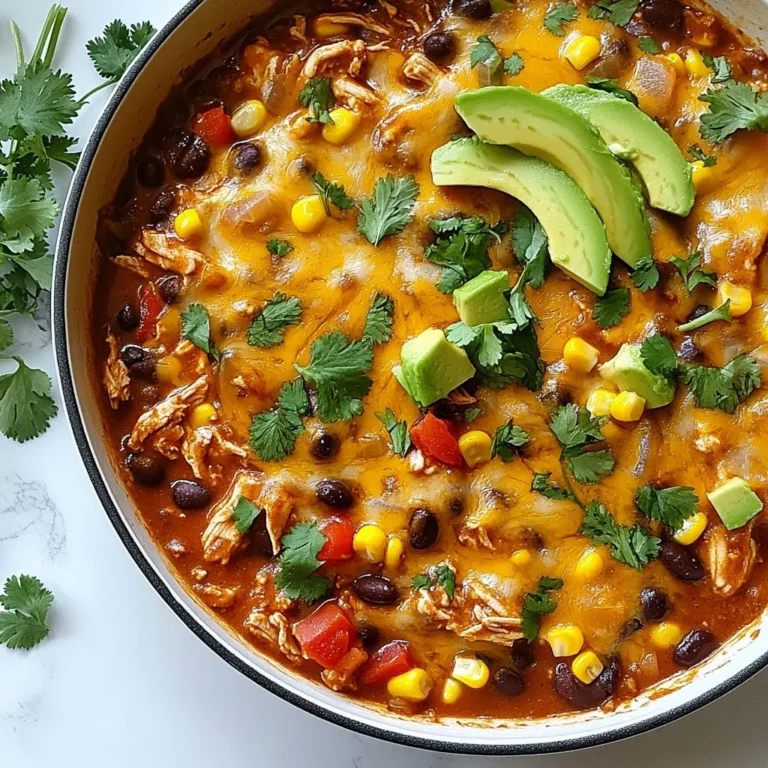
![- 4 large russet potatoes - 2 cups fresh broccoli florets, steamed to perfection - 1 cup sharp shredded cheddar cheese - 1/2 cup cream cheese, softened at room temperature To make cheesy broccoli stuffed potatoes, you need the right main ingredients. Start with large russet potatoes. These potatoes have thick skins and a fluffy inside. They hold the filling well. Next, grab fresh broccoli florets. Steaming them keeps their bright color and nutrients. For the cheesy goodness, use sharp cheddar cheese. It adds a bold flavor. Cream cheese makes the filling rich and creamy. Mixing these ingredients creates a tasty filling. - 1/4 cup sour cream for creaminess - 2 tablespoons unsalted butter, melted - 1 teaspoon garlic powder for flavor - Salt and freshly cracked black pepper to taste - Fresh chopped chives for an eye-catching garnish Seasonings enhance the flavors of your dish. Sour cream adds a nice creaminess. Melted butter gives richness to the filling. Garlic powder brings a warm, savory taste. Don't forget salt and pepper. They balance all the flavors perfectly. For a lovely garnish, use fresh chives. They add color and a mild onion taste. This combination of seasonings makes your cheesy broccoli stuffed potatoes even more delightful. For the full recipe, check [Full Recipe]. To start, you need to preheat your oven to 400°F (200°C). This helps ensure your potatoes bake evenly. Next, wash and scrub the russet potatoes to remove dirt. Use a fork to prick each potato 6-8 times. This allows steam to escape while baking. Place the potatoes on a baking sheet and bake them for 45-60 minutes. They should feel soft when you poke them with a fork. While your potatoes bake, it’s time to prepare the broccoli. Steam the fresh broccoli florets in a steamer basket over boiling water. This should take about 5-7 minutes. You want the broccoli to be bright green and tender. After steaming, set it aside to cool. In a large bowl, mix the steamed broccoli with shredded cheddar cheese, softened cream cheese, sour cream, melted butter, garlic powder, salt, and pepper. Stir until everything is creamy and well combined. Once your potatoes are done baking, take them out and let them cool for about 5 minutes. Cut each potato in half lengthwise. Scoop out some of the potato flesh, but leave a thin border for strength. Take the scooped potato and mix it into the cheesy broccoli filling. Stir until it is well blended. Now, spoon this mixture back into the potato skins. Make sure to pile it high for a nice look. Place the stuffed potatoes back on the baking sheet and return them to the oven. Bake for 15-20 minutes, or until the tops are golden and bubbly. Once they are ready, let them cool slightly before serving. You can find the full recipe for even more details on how to make this dish! To achieve a creamy consistency in your Cheesy Broccoli Stuffed Potatoes, you need the right balance of ingredients. Here’s how: - Use soft cheeses: Cream cheese and sour cream create a smooth mix. They help blend well with the broccoli. - Don’t overcook the broccoli: Steam it just until tender. Overcooking makes it mushy. - Mix well: Stir the cheese and broccoli together thoroughly. This way, every bite will be creamy. Ensuring the potatoes are fully cooked is crucial for best results. Here’s how to check: - Baking time: Bake russet potatoes for 45-60 minutes. They should feel soft when pierced. - Test for doneness: Use a fork to poke the potatoes. They should yield easily without resistance. You can add extra flavors to make your dish unique. Here are some ideas: - Bacon bits: Add crispy bacon for a salty crunch. It pairs well with broccoli. - Fresh herbs: Chopped chives or parsley can brighten the dish. They add a fresh taste. Adjusting spices can also elevate your stuffed potatoes. Here are some suggestions: - Garlic powder: Add more if you love garlic. It enhances the overall flavor. - Spice it up: A pinch of red pepper flakes gives a nice kick. For more details, check the Full Recipe. {{image_4}} You can switch up the cheese in your Cheesy Broccoli Stuffed Potatoes. Use different blends to create new flavors. For a milder taste, try using mozzarella or Monterey Jack. If you want a stronger flavor, go for Gouda or blue cheese. Mixing cheeses adds a fun twist to this dish! If you need a dairy-free option, try vegan cheese. Many brands offer tasty dairy-free cheese that melts well. You could also use nutritional yeast for a cheesy flavor without dairy. This keeps your dish creamy and delicious. Want to make your stuffed potatoes more filling? Add proteins! You can mix in cooked chicken or turkey. Shredded rotisserie chicken works great and saves time. For a vegetarian option, consider black beans or lentils. They add protein and make the dish hearty. If you love seafood, shrimp or crab can be exciting additions. Cook the seafood first, then fold it into the cheese and broccoli mix. This adds a unique flavor that makes your stuffed potatoes special. To store leftovers safely, let the stuffed potatoes cool to room temperature. Place them in an airtight container. You can keep them in the fridge for up to three days. When reheating, preheat your oven to 350°F (175°C). Place the stuffed potatoes on a baking sheet. Cover them with foil to prevent drying. Heat for about 15-20 minutes, or until they are hot throughout. This method helps keep them creamy and delicious. You can freeze stuffed potatoes for later use. First, let them cool completely after baking. Wrap each potato tightly in plastic wrap. Then, place them in a freezer bag or container. They can last up to three months in the freezer. When you want to enjoy them, take the potatoes out of the freezer. Let them thaw in the fridge overnight. Then, bake them in a preheated oven at 350°F (175°C) for about 30-40 minutes. Make sure they are hot inside before serving. This way, you can savor a tasty meal anytime. For the full recipe, check out the detailed steps included above. Cheesy broccoli stuffed potatoes are baked russet potatoes filled with a creamy mix of broccoli and cheese. The dish is hearty and comforting. You can serve them as a side or a main dish. They are perfect for family dinners or casual get-togethers. Kids and adults love this meal, making it a family favorite. To make these stuffed potatoes healthier, you can reduce calories by using low-fat cheese. You can also swap sour cream for Greek yogurt. This keeps the creaminess but cuts fat. Try using less butter or replacing it with olive oil for a healthier fat option. Fresh herbs can add flavor without extra calories. Yes, you can prepare cheesy broccoli stuffed potatoes ahead of time. After filling the potatoes, cover them and store them in the fridge for up to two days. When you are ready to eat, reheat them in the oven at 350°F (175°C) for about 20-25 minutes. Make sure they are warmed through before serving. In this post, we explored how to make Cheesy Broccoli Stuffed Potatoes. You learned about the key ingredients and the step-by-step process. I also shared tips and variations to make it your own. Remember, you can adjust flavors and textures to fit your taste. These stuffed potatoes are easy to prepare and perfect for any meal. Enjoy making them, and share your creations with friends and family!](https://goldendishy.com/wp-content/uploads/2025/07/b761c5e5-34eb-4a0c-a694-3380b074c9b4-768x768.webp)
